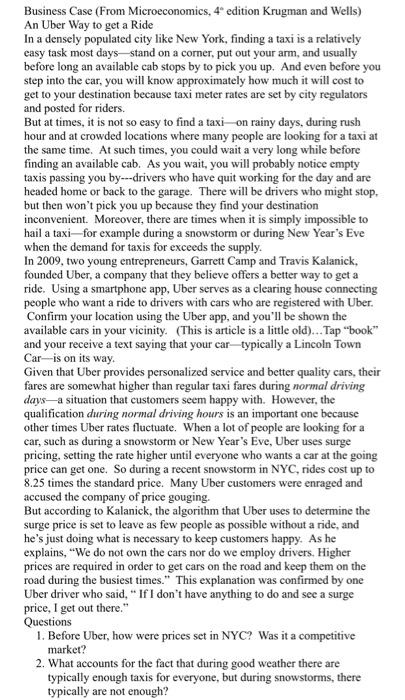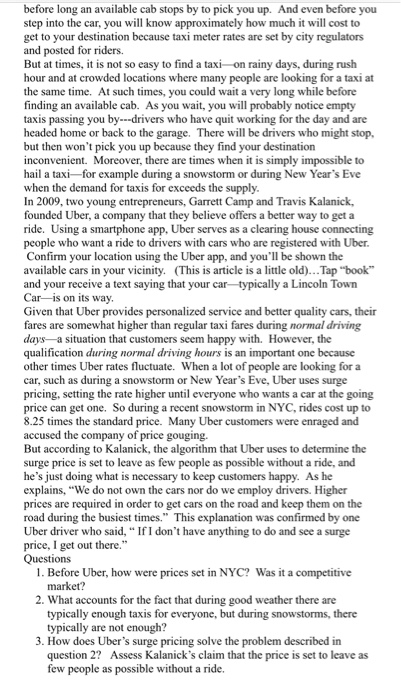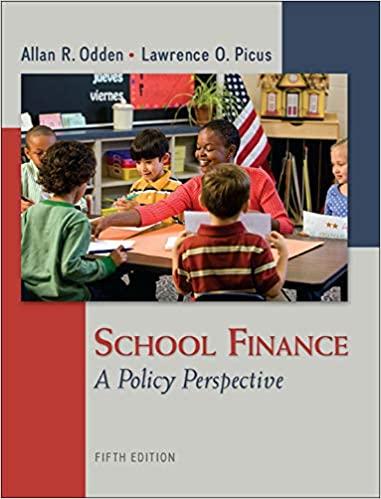Business Case (From Microeconomics, 4 edition Krugman and Wells) An Uber Way to get a Ride In a densely populated city like New York, finding a taxi is a relatively easy task most days stand on a corner, put out your arm, and usually before long an available cab stops by to pick you up. And even before y step into the car, you will know approximately how much it will cost to et to your destination because taxi meter rates are set by city regulators and posted for riders. But at times, it is not so easy to find a taxi on rainy days, during rush hour and at crowded locations where many people are looking for a taxi a the same time. At such times, you could wait a very long while before finding an available cab. As you wait, you will probably notice empty taxis passing you by-drivers who have quit working for the day and are headed home or back to the garage. There will be drivers who might stop but then won't pick you up because they find your destinatio inconvenient. Moreover, there are times when it is simply impossible to hail a taxi for example during a snowstorm or during New Year's Eve when the demand for taxis for exceeds the supply In 2009, two young entrepreneurs, Garrett Camp and Travis Kalanick founded Uber, a company that they believe offers a better way to get a ride. Using a smartphone app, Uber serves as a clearing house connecting people who want a ride to drivers with cars who are registered with Uber. Confirm your location using the Uber app, and you'll be shown the available cars in your vicinity. (This is article is a little old)...Tap "book" and your receive a text saying that your car typically a Lincoln Tow Car-is on its wa Given that Uber provides personalized service and better quality cars, their fares are somewhat higher than regular taxi fares during normal drivi days-a situation that customers seem happy with. However, the qualification during normal driving hours is an important one because other times Uber rates fluctuate. When a lot of people are looking for a car, such as during a snowstorm or New Year's Eve, Uber uses surge pricing, setting the rate higher until everyone who wants a car at the going price can get one. So during a recent snowstorm in NYC, rides cost up to 8.25 times the standard price. Many Uber customers were enraged and accused the company of price gouging. But according to Kalanick, the algorithm that Uber uses to determine the surge price is set to leave as few people as possible without a ride, and he's just doing what is necessary to keep customers happy. As he explains, "We do not own the cars nor do we employ drivers. Higher prices are required in order to get cars on the road and keep them on the road during the busiest times." This explanation was confirmed by one Uber driver who said, " If I don't have anything to do and see a surge price, I get out there Questions 1. Before Uber, how were prices set in NYC? Was it a competiti market? 2. What accounts for the fact that during good weather there are typically enough taxis for everyone, but during snowstorms, there typically are not enough? before long an available cab stops by to pick you up. And even before you step into the car, you will know approximately how much it will cost to get to your destination because taxi meter rates are set by city regulators and posted for riders. But at times, it is not so easy to find a taxi on rainy days, during rush hour and at crowded locations where many people are looking for a taxi at the same time. At such times, you could wait a very long while before finding an available cab. As you wait, you will probably notice empty taxis passing you by--drivers who have quit working for the day and ar headed home or back to the garage. There will be drivers who might stop, but then won't pick you up because they find your destination inconvenient. Moreover, there are times when it is simply impossible to hail a taxi for example during a snowstorm or during New Years Eve when the demand for taxis for exceeds the supply In 2009, two young entrepreneurs, Garret Camp and Travis Kalanick, founded Uber, a company that they believe offers a better way to get a ride. Using a smartphone app, Uber serves as a clearing house connecting people who want a ride to drivers with cars who are registered with Uber. Confirm your location using the Uber app, and you'll be shown the available cars in your vicinity. (This is article is a little old)...Tap "book" and your receive a text saying that your car typically a Lincoln Town Car-is on its way Given that Uber provides personalized service and better quality cars, their fares are somewhat higher than regular taxi fares during normal driving days a situation that customers seem happy with. However, the qualification during normal driving hours is an important one because other times Uber rates fluctuate. When a lot of people are looking for a car, such as during a snowstorm or New Year's Eve, Uber uses surge pricing, setting the rate higher until everyone who wants a car at the going price can get one. So during a recent snowstorm in NYC, rides cost up to 8.25 times the standard price. Many Uber customers were enraged and accused the company of price gouging But according to Kalanick, the algorithm that Uber uses to determine the surge price is set to leave as few people as possible without a ride, and he's just doing what is necessary to keep customers happy. As he explains, "We do not own the cars nor do we employ drivers. Higher prices are required in order to get cars on the road and keep them on the road during the busiest times." This explanation was confirmed by one Uber driver who said, " If I don't have anything to do and see a surge price, I get out there Questions 1. Before Uber, how were prices set in NYC? Was i a competitive market? 2. What accounts for the fact that during good weather there are typically enough taxis for everyone, but during snowstorms, there typically are not enough? 3. How does Uber's surge pricing solve the problem described in question 2? Assess Kalanick's claim that the price is set to leave as few pcople as possible without a rid








